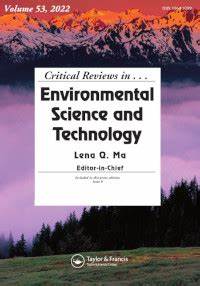Nanozymes: An innovative approach to regulating heavy metal accumulation in plants and alleviating toxicity-A comprehensive review
IF 13.2
1区 环境科学与生态学
Q1 ENVIRONMENTAL SCIENCES
Critical Reviews in Environmental Science and Technology
Pub Date : 2025-05-19
DOI:10.1080/10643389.2024.2448048
引用次数: 0
Abstract
Managing farmlands’ heavy metal (HM) pollution is crucial for improving plant growth and ensuring agricultural product safety. While low to medium doses of HM exposure may not directly result in crop reduction, they can lead to HM accumulation in plants and potential food-chain risks, as well as trigger the accumulation of reactive oxygen species (ROS). Excessive ROS can cause oxidative stress and irreversible damage to plant cells. Nanozymes, cost-effective and stable artificial nanoparticles with enzyme-like activity, have been widely used in multiple fields. Over the past decade, research has confirmed certain nanozymes’ effectiveness in plant systemic immunity during HM remediation. The activities of nanozymes hinge on their physicochemical properties, while the biological effects also depend on application methods, size, charge, coating, crop varieties, and growth stages. Therefore, it is crucial to understand the nanozyme-plant interactions and resistance mechanisms to HMs. This paper comprehensively reviews nanozyme-mediated ROS scavenging mechanisms across enzymology, metabolomics, proteomics, and transcriptomics. It also introduces the application pathways and effects, influencing factors, possible risks, and prospects. This review may provide a theoretical framework for nanozyme-mediated mitigation of HM stress along with other abiotic stresses in agriculture for sustainable “precision fertilization” with nanozymes.纳米酶:调控植物重金属积累和减轻毒性的创新方法综述
治理农田重金属污染对促进植物生长和确保农产品安全至关重要。虽然低至中等剂量的HM暴露可能不会直接导致作物减产,但它们会导致HM在植物中的积累和潜在的食物链风险,并引发活性氧(ROS)的积累。过量的活性氧会引起植物细胞的氧化应激和不可逆损伤。纳米酶是一种经济、稳定、具有类酶活性的人工纳米颗粒,已广泛应用于多个领域。在过去的十年中,研究证实了某些纳米酶在HM修复过程中对植物全身免疫的有效性。纳米酶的活性取决于其物理化学性质,而其生物学效应还与施用方法、粒径、电荷、包衣、作物品种和生长阶段有关。因此,了解纳米酶与植物的相互作用和抗性机制是至关重要的。本文全面综述了纳米酶介导的活性氧清除机制,包括酶学、代谢组学、蛋白质组学和转录组学。介绍了应用途径和效果、影响因素、可能存在的风险和前景。这一综述为纳米酶介导的缓解HM胁迫以及农业中其他非生物胁迫,实现纳米酶可持续“精准施肥”提供了理论框架。
本文章由计算机程序翻译,如有差异,请以英文原文为准。
求助全文
约1分钟内获得全文
求助全文
来源期刊
CiteScore
27.30
自引率
1.60%
发文量
64
审稿时长
2 months
期刊介绍:
Two of the most pressing global challenges of our era involve understanding and addressing the multitude of environmental problems we face. In order to tackle them effectively, it is essential to devise logical strategies and methods for their control. Critical Reviews in Environmental Science and Technology serves as a valuable international platform for the comprehensive assessment of current knowledge across a wide range of environmental science topics.
Environmental science is a field that encompasses the intricate and fluid interactions between various scientific disciplines. These include earth and agricultural sciences, chemistry, biology, medicine, and engineering. Furthermore, new disciplines such as environmental toxicology and risk assessment have emerged in response to the increasing complexity of environmental challenges.
The purpose of Critical Reviews in Environmental Science and Technology is to provide a space for critical analysis and evaluation of existing knowledge in environmental science. By doing so, it encourages the advancement of our understanding and the development of effective solutions. This journal plays a crucial role in fostering international cooperation and collaboration in addressing the pressing environmental issues of our time.

 求助内容:
求助内容: 应助结果提醒方式:
应助结果提醒方式:


